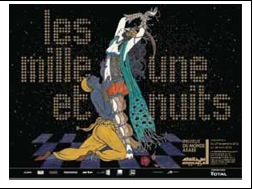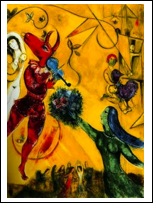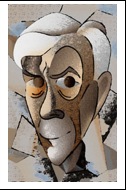The finest exhibitions are billed for Paris in 2013
With major retrospectives and wide-ranging themes, Parisian museums are maintaining their status in the top billing in 2013. The highlights of a spectacular season include Marc Chagall, Georges Braque, Marie Laurencin and the enchantment of the Tales from A Thousand and One Nights.
Defying all budgetary restrictions, the 2013 programme of major exhibitions promises to be particularly packed and diverse. Whether your passion is for ancient, modern or contemporary art, painting, sculpture or photography, we’ll give you an overview of some exhibitions not to be missed.
The Orient and its mysteries
 At the Institut du Monde Arabe, until 28 April, you can see a magnificent exhibition of 350 works inspired by the Tales from A Thousand and One Nights in every different field of art: from music to theatre, through painting and literature, opera and cinema, photography and fashion.
At the Institut du Monde Arabe, until 28 April, you can see a magnificent exhibition of 350 works inspired by the Tales from A Thousand and One Nights in every different field of art: from music to theatre, through painting and literature, opera and cinema, photography and fashion.
Plunged into semi-darkness, carried along by the voice of the tales, to the rhythms of Night succeeding Night, the visitor can explore ancient manuscripts, sculptures, unusual paintings and curios, all of them keys to understanding this masterpiece of world literature, an exceptional link between the East and West.
The wonderful text in Arabic, of Persian and Indian origin, whose authors remain anonymous, was first translated into French by Antoine Galland in the 18th century. The exhibition retraces the history of this collection of enchanting tales and its world of journeys and illusions that have been the stuff of dreams for centuries. The wonderful storyteller Scheherazade, symbol of the emancipatory power of the word and knowledge, Aladdin and his magic lamp, Sinbad the Sailor, all those legendary characters that people our imaginations. You can also see a drawing of Scheherazade by Picasso or watch extracts from Pasolini’s 1974 film Arabian Nights.
From Tsarist Russia to Saint-Paul de Vence
The Musée du Luxembourg will be the centre of attention when it hosts the unclassifiable Marc Chagall, from 21 February to 21 July 2013. The exhibition is entitled Entre Guerre et Paix
 [Between War and Peace]. An original theme that looks at the painter’s work from a new angle: his personal experience of war and peace expressed through his art. Marc Chagall (1887-1985) experienced a revolution, two wars and two exiles and he rubbed shoulders with the greatest artists of his time. The hundred or so works on show retrace the life of this Byelorussian, his memories, his meetings and his journeys, through four fundamental themes: the Russian years, the interwar period in Paris, exile in the United States, and the post-war period in the south of France. His paintings, drawings and engravings bear the stamp of all these tragedies. A seriousness flows from his creation, but also a certain happiness. The final works evoke serenity and peace finally found, into which the painter plunges his figures and floats with them in the intense space of colour. This serenity reaches its peak in The Dance, a genuine hymn to joy which includes the principal figures of Chagall’s world.
[Between War and Peace]. An original theme that looks at the painter’s work from a new angle: his personal experience of war and peace expressed through his art. Marc Chagall (1887-1985) experienced a revolution, two wars and two exiles and he rubbed shoulders with the greatest artists of his time. The hundred or so works on show retrace the life of this Byelorussian, his memories, his meetings and his journeys, through four fundamental themes: the Russian years, the interwar period in Paris, exile in the United States, and the post-war period in the south of France. His paintings, drawings and engravings bear the stamp of all these tragedies. A seriousness flows from his creation, but also a certain happiness. The final works evoke serenity and peace finally found, into which the painter plunges his figures and floats with them in the intense space of colour. This serenity reaches its peak in The Dance, a genuine hymn to joy which includes the principal figures of Chagall’s world.
“The muse inspiring the poet”
The Musée Marmottan Monet sets out to spoil lovers of Impressionist art by paying vivid tribute to Marie Laurencin from 21 February to 30 June 2013. This exhibition, which includes some ninety works of art, is the first to be held in a French museum. Muse to Guillaume Apollinaire,
 friend of Braque and Picasso, a colourful figure of the Roaring Twenties, Marie Laurencin is one of the most famous women painters of the 20th century. In 1907, she joined the circle of artists who frequented the Bateau-Lavoir, the famous residence and haunt of many artists in Paris.
friend of Braque and Picasso, a colourful figure of the Roaring Twenties, Marie Laurencin is one of the most famous women painters of the 20th century. In 1907, she joined the circle of artists who frequented the Bateau-Lavoir, the famous residence and haunt of many artists in Paris.
A large majority of the works on show come from the art collection devoted to her by Japanese patrons of the arts, Masahiro Takano and his son, for over thirty years. The exhibition reveals a broad panorama of the artist’s work, a sweet and tender world. Her subtle ranges of colour in half tones and her brushstrokes of solid colour belong to her alone. The poetic world she portrays, peopled with amazons and doves, and her feminine elegance, merit all the accolades. A portraitist, the artist liked to paint women, and even produced for posterity around thirty self-portraits. Highly regarded abroad, Marie Laurencin embodied with delicacy and inspiration the French style that particularly beguiled art lovers in Europe and America.
“There is only one valuable thing in art: the thing you cannot explain”
 A vast retrospective of the multifaceted art of Georges Braque, the French grand master of Cubism, will be held at the Grand Palais from 18 September 2013 to 6 January 2014. Every period of his creative life is presented here, from Fauvism to his final work, which culminated in the dazzling series of studios and birds. Internationally recognised as one of the major painters of the 20th century, he was also much loved for his human qualities and his engaging personality. Braque became famous as much in the fields of landscape and still life as in those of the portrait and the interior scene.
A vast retrospective of the multifaceted art of Georges Braque, the French grand master of Cubism, will be held at the Grand Palais from 18 September 2013 to 6 January 2014. Every period of his creative life is presented here, from Fauvism to his final work, which culminated in the dazzling series of studios and birds. Internationally recognised as one of the major painters of the 20th century, he was also much loved for his human qualities and his engaging personality. Braque became famous as much in the fields of landscape and still life as in those of the portrait and the interior scene.
The exhibition tour stresses the high points of the exceptional work of the artist, such as Cubism, the canephorae of the Twenties and the late landscapes so admired by Nicolas de Staël. The exhibition contains key works as well as series of variations on a theme: canephorae, pedestal tables and studios. Other perspectives are considered in this ambitious exhibition: his collaboration with Picasso during Cubism; the close relationship of his art with music and his closeness to Erik Satie; his fellowship with poets such as Pierre Reverdy, René Char and Francis Ponge and the prominent intellectual figures of his time, such as Jean Paulhan and Carl Einstein. Part of the exhibition is devoted to the work of Georges Braque as viewed by photographers Man Ray, Doisneau and Cartier-Bresson.
A significant economic benefit
Once again, French museums are showing record attendances and Paris remains one of the world’s leading cultural capitals. 44 million visitors were counted in 2011, a rise of 5.5 % on the previous year. Several exhibitions recorded over 7000 visitors a day. The Louvre, the Musée d’Orsay and the Musée du Quai Branly were the chief beneficiaries of this rise. A good recovery in the numbers of Americans and the growing presence of visitors from emerging countries should be noted. There is no crisis when it comes to culture.